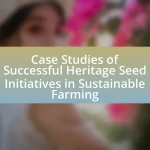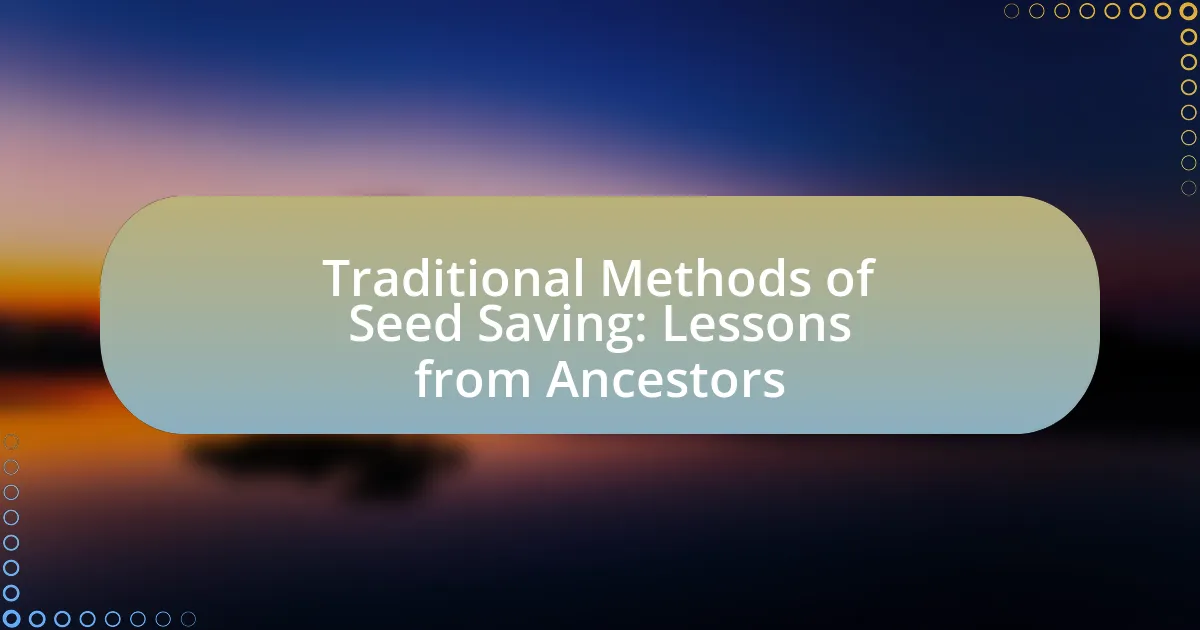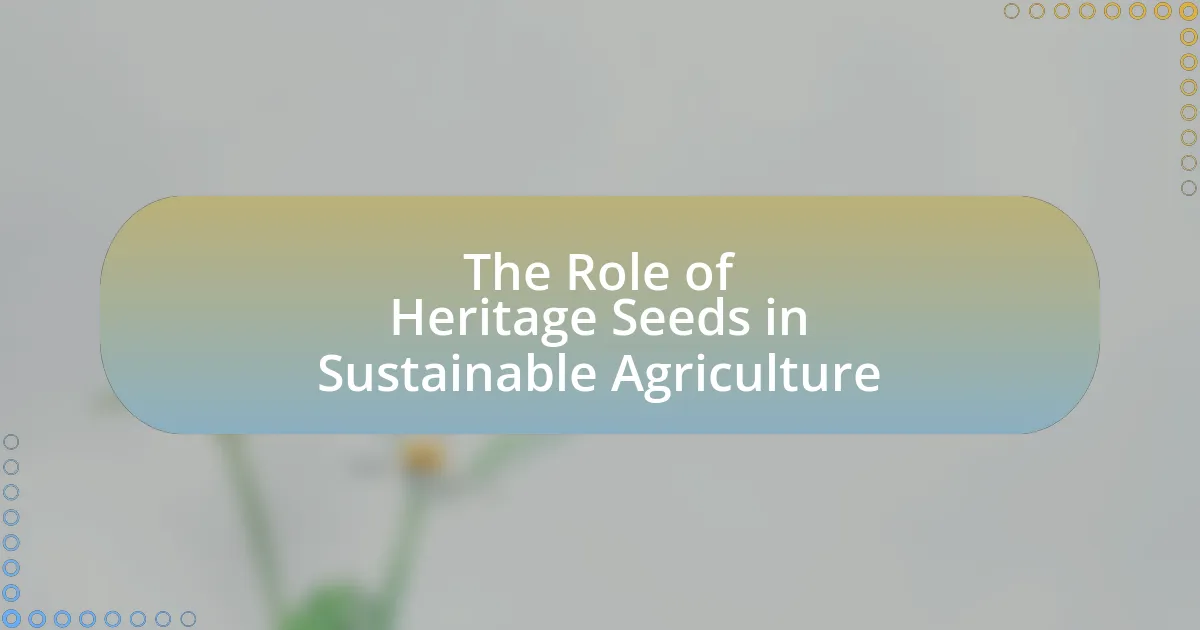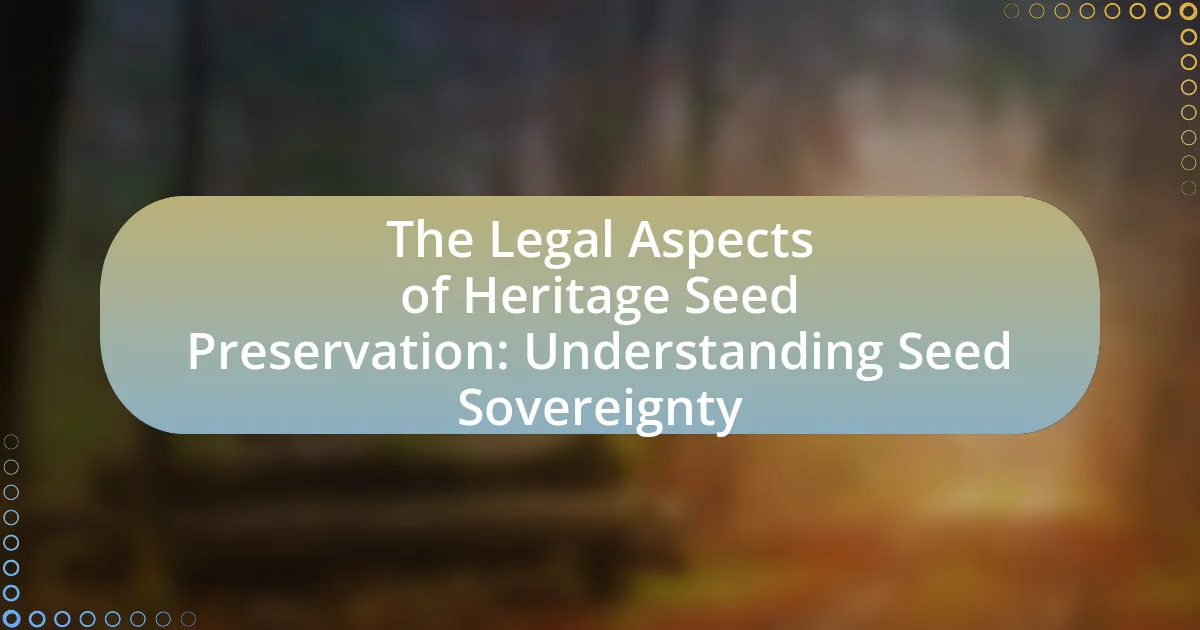The article explores the science behind seed longevity, emphasizing the factors that influence how long seeds can remain viable, such as moisture content, temperature, and genetic diversity. It highlights the remarkable ability of certain seeds, including heritage varieties, to endure for decades or even centuries under optimal conditions. The discussion includes the biological processes that contribute to seed longevity, the impact of environmental exposure, and the unique characteristics of heritage seeds compared to modern hybrids. Additionally, the article addresses effective methods for preserving heritage seeds and their benefits for biodiversity, nutrition, and local agriculture.
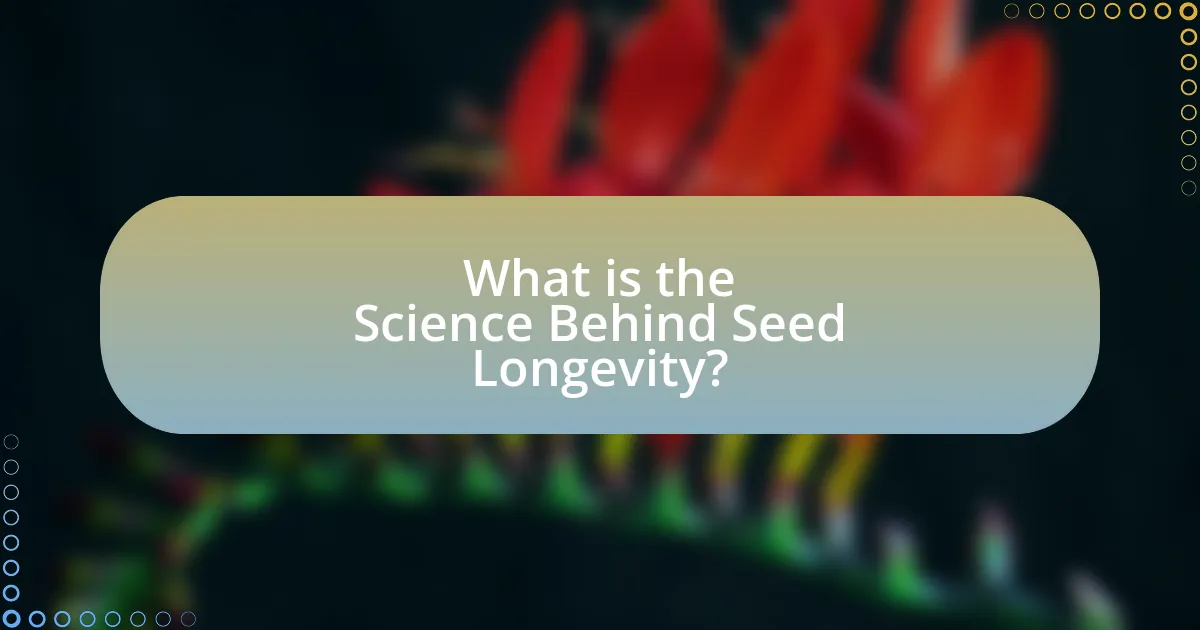
What is the Science Behind Seed Longevity?
Seed longevity is primarily influenced by factors such as seed moisture content, temperature, and the presence of protective structures. Research indicates that seeds with lower moisture content can remain viable for decades, as demonstrated by the successful germination of seeds found in ancient tombs, which were over 2,000 years old. Additionally, seeds stored at cooler temperatures experience slower metabolic rates, further extending their lifespan. The protective seed coat also plays a crucial role by shielding the embryo from environmental stressors and pathogens, thereby enhancing longevity.
How do seeds maintain their viability over time?
Seeds maintain their viability over time primarily through the preservation of their internal moisture content and metabolic activity. When seeds are dry, they enter a state of dormancy, significantly slowing down their metabolic processes and reducing the risk of deterioration. Research indicates that seeds can remain viable for decades or even centuries when stored in optimal conditions, such as low humidity and cool temperatures. For example, seeds of the Arctic tundra plant, Silene stenophylla, have been successfully germinated after being frozen for over 32,000 years, demonstrating the remarkable longevity of seeds under the right conditions.
What biological processes contribute to seed longevity?
Seed longevity is primarily influenced by biological processes such as desiccation tolerance, metabolic rate reduction, and the accumulation of protective compounds. Desiccation tolerance allows seeds to survive extreme drying, which is crucial for maintaining viability over time. A reduction in metabolic rates during dormancy minimizes energy consumption and cellular damage, thereby extending lifespan. Additionally, the accumulation of protective compounds like antioxidants and storage proteins helps to mitigate oxidative stress and cellular degradation, further enhancing seed longevity. These processes are supported by research indicating that seeds with higher levels of these protective compounds exhibit greater longevity under various environmental conditions.
How does environmental exposure affect seed lifespan?
Environmental exposure significantly impacts seed lifespan by influencing physiological processes such as germination and dormancy. Factors like temperature, humidity, and light can accelerate seed aging or enhance longevity. For instance, seeds exposed to high temperatures and humidity levels experience increased metabolic activity, leading to faster deterioration and reduced viability. Research indicates that seeds stored in cooler, drier conditions can maintain viability for decades, while those in unfavorable environments may lose germination potential within a few years. This relationship underscores the importance of environmental conditions in determining seed longevity and viability.
Why are heritage seeds considered unique?
Heritage seeds are considered unique because they are open-pollinated varieties that have been passed down through generations, preserving genetic diversity and historical significance. These seeds maintain traits that are well-adapted to local environments and often exhibit superior flavor and nutritional value compared to hybrid varieties. For instance, heritage tomatoes are known for their rich taste, which is a result of their long cultivation history. Additionally, heritage seeds contribute to biodiversity, as they are not subject to the same commercial pressures as modern hybrids, allowing them to thrive in various growing conditions.
What characteristics differentiate heritage seeds from modern hybrids?
Heritage seeds are characterized by their open-pollinated nature, allowing them to be saved and replanted year after year, while modern hybrids are typically bred for specific traits and often require purchasing new seeds each season. Heritage seeds maintain genetic diversity and adaptability, having been cultivated over generations, whereas modern hybrids are engineered for uniformity and higher yields, often at the expense of flavor and resilience. Historical data shows that heritage varieties can withstand local pests and diseases better due to their genetic variability, contrasting with the vulnerability of many hybrids that are bred for specific conditions.
How do heritage seeds contribute to biodiversity?
Heritage seeds contribute to biodiversity by preserving a wide range of genetic variations within plant species. These seeds, often heirloom varieties, maintain traits that have adapted to specific local environments over generations, which enhances ecosystem resilience. For example, the Seed Savers Exchange reports that heritage seeds can include thousands of unique varieties, each with distinct characteristics that can withstand different pests, diseases, and climate conditions. This genetic diversity is crucial for food security and agricultural sustainability, as it allows for a broader selection of crops that can adapt to changing environmental conditions.

What Factors Influence Seed Longevity?
Seed longevity is influenced by several key factors, including moisture content, temperature, and seed genetics. Moisture content is critical; seeds stored at lower moisture levels tend to have longer viability, as high moisture can lead to fungal growth and decay. Temperature also plays a significant role; seeds stored in cooler environments generally maintain their viability longer than those kept in warmer conditions. Additionally, the genetic makeup of the seed affects its longevity; certain species and varieties are naturally more resilient and can endure longer periods of dormancy. Research indicates that seeds with optimal storage conditions can remain viable for decades, highlighting the importance of these factors in seed preservation.
How does seed storage impact longevity?
Seed storage significantly impacts longevity by preserving seed viability and preventing deterioration. Proper storage conditions, such as low humidity and cool temperatures, can extend the lifespan of seeds, allowing them to remain viable for years or even decades. For example, seeds stored at temperatures below 5°C and with moisture content below 5% can maintain viability for over 20 years, as evidenced by research conducted by the Seed Bank at the University of Reading, which found that optimal conditions can double the longevity of seeds compared to those stored in less ideal environments.
What are the best practices for storing seeds?
The best practices for storing seeds include keeping them in a cool, dry, and dark environment to maintain their viability. Seeds should be placed in airtight containers, such as glass jars or vacuum-sealed bags, to protect them from moisture and pests. Additionally, labeling containers with the seed type and date of storage helps track their age and ensures proper usage. Research indicates that seeds stored at lower temperatures (around 32°F or 0°C) can significantly extend their lifespan, with some seeds remaining viable for decades under optimal conditions.
How does temperature and humidity affect seed viability?
Temperature and humidity significantly influence seed viability by affecting metabolic processes and dormancy. High temperatures can accelerate seed aging and reduce germination rates, while low temperatures may prolong dormancy but can also lead to chilling injury in some species. Humidity levels impact seed moisture content; excessive moisture can lead to fungal growth and decay, while low humidity can cause seeds to dry out and lose viability. Research indicates that seeds stored at optimal temperatures (around 5°C) and humidity levels (below 15% moisture content) can maintain viability for extended periods, as demonstrated in studies by the Seed Conservation Program at the Royal Botanic Gardens, Kew, which found that proper storage conditions can significantly extend seed longevity.
What role does genetic diversity play in seed longevity?
Genetic diversity significantly enhances seed longevity by increasing resilience to environmental stressors and pathogens. Seeds with a broader genetic base are more likely to possess traits that allow them to survive adverse conditions, such as drought or disease, which can otherwise lead to seed degradation. Research indicates that diverse genetic backgrounds contribute to a higher likelihood of successful germination and viability over time, as seen in studies where genetically diverse seed populations outperformed homogeneous ones in longevity tests. For instance, a study published in the journal “Seed Science Research” demonstrated that genetically diverse seed lots maintained higher germination rates after prolonged storage compared to genetically uniform seed lots, underscoring the critical role of genetic diversity in promoting seed longevity.
How does genetic variation enhance resilience in seeds?
Genetic variation enhances resilience in seeds by providing a diverse pool of traits that can improve survival and adaptability to changing environmental conditions. This diversity allows some seeds to withstand stressors such as drought, pests, and diseases, which can be critical for their survival and successful germination. For example, studies have shown that populations with higher genetic diversity exhibit greater resistance to pathogens and environmental fluctuations, as seen in research conducted by the University of California, which found that genetically diverse plant populations had a 50% higher survival rate under stress conditions compared to genetically uniform populations. This evidence underscores the importance of genetic variation in promoting the resilience and longevity of seeds.
What are the implications of genetic erosion on seed longevity?
Genetic erosion negatively impacts seed longevity by reducing genetic diversity, which is crucial for resilience and adaptability. When genetic diversity diminishes, seeds become more susceptible to diseases, pests, and environmental changes, leading to decreased viability over time. Research indicates that crops with higher genetic diversity exhibit better longevity and adaptability, as seen in studies of heirloom varieties that maintain traits allowing them to thrive in varying conditions. Thus, the loss of genetic variation directly correlates with a decline in seed longevity and overall agricultural sustainability.

How Can We Preserve Heritage Seeds?
To preserve heritage seeds, implement seed saving practices that include collecting seeds from mature plants, ensuring they are properly dried and stored in a cool, dark, and dry environment. This method is crucial because heritage seeds are open-pollinated and retain genetic diversity, which is vital for future planting. Studies indicate that proper storage can extend seed viability for many years; for example, seeds stored at low humidity and temperatures can remain viable for over a decade. Additionally, participating in seed banks or community seed exchanges can help maintain genetic diversity and provide a network for sharing and preserving these unique varieties.
What methods are effective for seed conservation?
Effective methods for seed conservation include seed banking, in situ conservation, and community seed saving initiatives. Seed banking involves storing seeds in controlled environments to maintain their viability over time, with organizations like the Svalbard Global Seed Vault exemplifying this method by preserving a diverse range of plant genetic material. In situ conservation focuses on protecting seeds in their natural habitats, ensuring that ecosystems remain intact and that plants can adapt to changing conditions. Community seed saving initiatives empower local farmers to preserve traditional varieties, fostering biodiversity and resilience against climate change. These methods collectively enhance the preservation of genetic diversity, which is crucial for food security and agricultural sustainability.
How does seed banking contribute to preserving heritage seeds?
Seed banking contributes to preserving heritage seeds by providing a controlled environment for their storage, ensuring genetic diversity and long-term viability. This method allows for the collection and preservation of seeds from various heritage varieties, which are often at risk of extinction due to industrial agriculture practices. According to the Food and Agriculture Organization, seed banks can store seeds for decades, maintaining their genetic integrity and enabling future generations to access these unique genetic resources. By safeguarding these seeds, seed banks play a crucial role in maintaining agricultural biodiversity and supporting sustainable farming practices.
What community practices support heritage seed preservation?
Community practices that support heritage seed preservation include seed saving, community seed banks, and educational workshops. Seed saving involves individuals or groups collecting and storing seeds from plants grown in their gardens, ensuring the continuation of diverse plant varieties. Community seed banks serve as repositories for these seeds, allowing local farmers and gardeners to access and share heritage seeds, thus promoting biodiversity. Educational workshops raise awareness about the importance of heritage seeds and teach techniques for their cultivation and preservation, fostering a culture of sustainability and resilience within the community. These practices collectively contribute to the conservation of genetic diversity in agriculture and the maintenance of traditional farming methods.
What are the benefits of growing heritage seeds?
Growing heritage seeds offers numerous benefits, including biodiversity preservation, improved flavor, and adaptability to local growing conditions. Heritage seeds are open-pollinated varieties that have been cultivated for generations, ensuring genetic diversity which helps maintain ecosystem resilience. Studies show that these seeds often produce crops with superior taste compared to hybrid varieties, enhancing culinary experiences. Additionally, heritage seeds are typically better suited to specific regional climates and soils, allowing for more sustainable farming practices. This adaptability can lead to higher yields and reduced reliance on chemical inputs, supporting both environmental health and food security.
How do heritage seeds impact local agriculture?
Heritage seeds positively impact local agriculture by promoting biodiversity and resilience in farming systems. These seeds, which are open-pollinated and often adapted to local climates, contribute to a diverse gene pool that can enhance crop resilience against pests, diseases, and climate variability. For instance, a study published in the journal “Agricultural Systems” found that farms utilizing heritage seeds exhibited greater yield stability compared to those relying solely on commercial hybrids, particularly in adverse weather conditions. This stability is crucial for local farmers, as it supports food security and sustainable agricultural practices.
What nutritional advantages do heritage seeds offer?
Heritage seeds offer enhanced nutritional advantages, including higher levels of vitamins, minerals, and antioxidants compared to conventional seeds. Research indicates that heritage varieties often retain more diverse genetic traits, which can lead to improved nutrient profiles. For instance, studies have shown that heirloom tomatoes contain significantly higher concentrations of vitamin C and phenolic compounds than their hybrid counterparts. This increased nutritional density is attributed to the traditional farming practices that prioritize flavor and nutrient content over uniformity and shelf life.
What practical tips can help gardeners with heritage seeds?
To successfully cultivate heritage seeds, gardeners should prioritize seed saving, proper storage, and soil health. Seed saving allows gardeners to preserve unique varieties and maintain genetic diversity, which is crucial for long-term sustainability. Proper storage involves keeping seeds in a cool, dark, and dry environment to maintain viability; research indicates that seeds stored under these conditions can remain viable for several years. Additionally, enhancing soil health through organic practices, such as composting and crop rotation, supports the growth of heritage plants, as these seeds often thrive in nutrient-rich soils.


